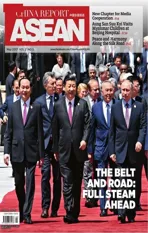KEYWORDS TO UNDERSTAND CHINA
2017-03-28
TO UNDERSTAND CHINA
“五通”
2013年9月7日,习近平主席在哈萨克斯坦纳扎尔巴耶夫大学发表演讲,首次提出加强“政策沟通、道路联通、贸易畅通、货币流通、民心相通”,共同建设“丝绸之路经济带”的战略倡议。2015年3月28日,中国政府在博鳌亚洲论坛2015年年会期间正式发布《推动共建丝绸之路经济带和21世纪海上丝绸之路的愿景与行动》,提出要以“政策沟通、设施联通、贸易畅通、资金融通、民心相通”(简称“五通”)为主要内容,打造“一带一路”沿线国家政治互信、经济融合、文化互容的利益共同体、责任共同体和命运共同体。在“一带一路”建设全面推进过程中,“五通”既相互独立,在不同时间阶段各有重点,也是统一整体,需要相互促进,不可分割。
FIVE-PRONGED APPROACH
In his speech at Kazakhstan’s Nazarbayev University on September 7, 2013, President Xi Jinping proposed building a Silk Road Economic Belt by promoting policy coordination, road connectivity, unimpeded trade, currency convertibility, and closer people-to-people ties.
At the Boao Forum for Asia on March 28, 2015, the Chinese government issued a white paper entitledJoining Hands to Build a Silk Road Economic Belt and a 21st-Century Maritime Silk Road – Vision and Actions. This document also calls for policy coordination, connectivity of infrastructure and facilities, unimpeded trade, financial integration,and closer people-to-people ties (a five-pronged approach), so as to build a community of shared interests, of shared responsibility and of a shared future on the basis of mutual trust, economic integration and cultural inclusiveness. While the five components of this approach are distinct from one another and will have a shifting focus at different stages in building the Belt and Road, they form an integrated whole, and both are inseparable and mutually reinforcing.
政策沟通
政策沟通是“一带一路”建设的重要保障。政策沟通的基本含义是:在深化利益融合、促进政治互信并达成合作新共识的前提下,本着求同存异的原则,沿线各国积极构建政府间宏观政策沟通的交流机制,就经济发展战略和对策进行充分交流对接,共同制定推进区域合作的规划和措施,协商解决合作中的问题,共同为务实合作及大型项目实施提供政策支持,从而形成趋向一致的战略、决策、政策和规则,结成更为巩固的命运共同体。
POLICY COORDINATION
Policy coordination is key to the effective implementation of the Belt and Road Initiative. In order to expand shared interests, enhance mutual trust and build consensus on further cooperation, it is important for the countries along the Belt and Road to seek common ground while shelving differences, and increase inter-governmental communication on macroeconomic policy and development strategies so as to better align their national priorities with regional planning needs and common goals. Cooperation related issues and challenges should be dealt with through consultation, and policy support is needed to promote a pragmatic approach to implementing large-scale projects. Joint efforts have to be made to harmonize strategies, decision-making processes, policies and rules, so as to build a stronger community of shared future.
